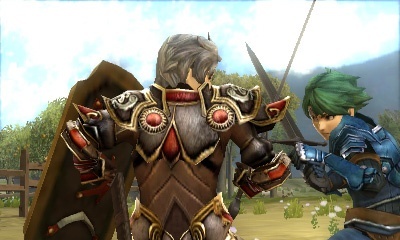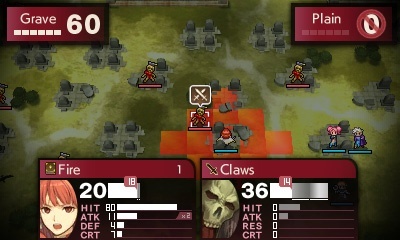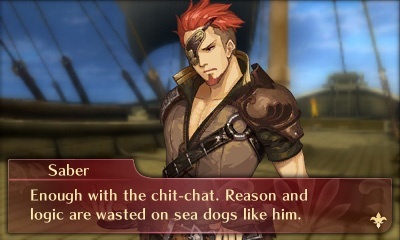Fire Emblem Echoes: Shadows of Valentia (Nintendo 3DS) Review
By Rudy Lavaux  16.05.2017
16.05.2017

Who would have thought that with the Nintendo Switch being already available, and being essentially a handheld system at core, that Nintendo would push forward with another Fire Emblem for 3DS? Announced a mere three months before actual release, it seems like a miracle that such a plan had not transpired earlier through rumours. Nevertheless, the Nintendo 3DS is not done yet, as this latest piece of Fire Emblem history, a remake of the Famicom second instalment from 1992, finally lands on the handheld. Unlike Fire Emblem: Shin Monshou no Nazô released before it late in the original Nintendo DS' life in 2010, and which remained exclusive to Japan, Western gamers did not have to wait very long to be allowed to sample this new treat. Following on from the early hands-on report, Cubed3 dives right back in to deliver the final verdict on Fire Emblem Echoes: Shadows of Valentia…
Valentia, the continent on which this Fire Emblem takes place - which happens to be in the same universe as Archanea, the continent featured in the very first Fire Emblem and its remake, Fire Emblem: Shadow Dragon - was once fought over by two Gods, the goddess Mila who thought that humans should not be ruled by force but instead left to freely live their lives, and the God Duma who thought humans should be ruled over with strength and discipline. They ultimately decided to split the world in two, for both of them to share and rule over in their own way. Duma founded the Empire of Rigel, who swears only by a hard life and discipline, while the people of the Kingdom of Zofia enjoy a carefree life, free of constraints and enjoy the pleasures of life on a daily basis. Soon, however, Rigel invades the Kingdom of Zofia to punish them for their insolence and chancellor Desaix defects and kills the good king of Zofia, therefore helping Rigel with their invasion plan. In the midst of all this, Alm, the grandson of a knight called Mycen and a resident of Zofia, grew up to learn the art of the sword after being separated from his childhood best friend Celica and finds himself engaged in the Zofian liberation militia called "The Deliverance."
The two main playable heroes, Alm and Celica, play their separate ways as two different acts at first, although they later rejoin and meet again after many years of separation. They soon after split off again, though, and the player is free to play both storylines in parallel, each with its own party, leader, and inventory separate from the other. It is, however, possible to send an item to the other party by requesting a travelling merchant to bring them the object, which is then instantly transferred to the other party's convoy. The plot itself and the way it all works out is not altogether unseen stuff, as later episodes build upon those same ideas. It's a new mixture thereof, but it definitely feels like a very classic take on Fire Emblem indeed. Characters still fight on the battlefield, move a couple squares and engage the enemy, they level up by gaining experience through fights and gain some stat boosts by doing so. Characters can class-up after they have levelled up enough and their initial class often lets the player choose their path on the first class up, but the second class up afterwards usually doesn't give much choice, so characters are set early on a one-way track.
There are plenty of changes to the basic formula of Fire Emblem with this episode, however, a lot of which are due to the fact that this being a remake, meaning several key components that were added to the series years later after the original was released were not added back in for the remake, or not in the same way that fans would expect them to work, like the classic weapon triangle being absent.

Another example is that units in the game accumulate fatigue, the more they are used. Contrary to what was initially wrongly assumed in the early hands-on preview, a fatigued status only results in that unit seeing its maximum HP greatly reduced, at least until that character gets restored by going back to the main map, by eating or drinking a restorative item, or making an offering at a statue of Mila. Another new element is that each character always has a default useable weapon that is determined by their class, and can carry only one additional item with them, be it a restorative item, a shield, or any kind of item that provides a small stat boost or, more importantly, a more specific weapon than the default one. Weapons can be forged to improve their effects and, eventually, evolve them into downright better items at blacksmiths found in certain key villages that both parties only reach later on. Forging requires silver and gold marks - a currency found lying around, especially inside dungeons. Carrying a weapon or object and using them in battle allows the wielder to improve their proficiency with it, which then allows them to learn new skills that activate automatically so long as that related object is being held, arts that are manually selected special attacks, or magic that bears special effects when used. Sadly, however, once a skill is learned, it remains in the list for that character but said list doesn't make it clear what weapon it was that needed to be wielded in order to use it again later, which is unfortunate.
Clerics and mages work in a special way, in that they learn new spells as they level up naturally instead of them needing specific tomes. The definitive weirdest part of it is that such skills learned from holding certain weapons or accessories, as well as magic, consume the user's HP with each use! This certainly is a bit disconcerting, especially at first, and this was already a particularity of the original. However, the cost is usually not high, at least not for the skills and spells that will be more commonly used, and clerics at least always have the Nosferatu spell, which lets them restore their HP by sapping it from enemy units themselves, which is very useful.
An important component of the experience and an addition to this remake that wasn't in the original is Mila's turnwheel. It is a powerful magical artefact that lets its user turn back time a maximum of three times per battle, unless the player happens to have found cogs while exploring villages or dungeons, which let them turn back time one additional time apiece if he or she has already run out of those three tries. Moreover, the turnwheel recharges itself automatically at the end of each battle, so gamers can feel free to use it if things start getting nasty to go back at any previous stage of the battle, even several turns prior without having to restart it from the very beginning, which does make this particular episode of the Fire Emblem saga easier to approach as errors do not weigh nearly as much in terms of consequences.

For the most cunning out there: it cannot be abused to re-roll stat boosts upon level-up. This was tried during the review process and the same stat boosts occur again and again, even if time is wound back. Lastly, the turnwheel, when used outside of battles at statues of Mila, gives access to visions that show the past of the playable characters in exchange for Memory Prisms. The latter are found while examining locations viewed in first-person as sparkly items, easily missed. Such visions provide interesting insight into the origins of each character and how they came to be at the point where the hero met them. Of course, some of those memories also shed light on the mysterious past of the heroes themselves. As previously mentioned in Cubed3's preview, the biggest and most taunted particularity of this new release is dungeon exploration. Those sequences have the hero character roaming indoor places, looking for the exit first and foremost, but encountering enemies along the way and also finding treasure chests. Certain parts of those maze-like places tend to be hidden behind breakable walls, but there's usually a visual hint to indicate that something is hidden there. Dungeons usually end with a big room where a statue of the Goddess Mila is found, which lets the player both class up and restore from their fatigue, as well as two Lion Head fountains from which holy water flows that increases one specific stat by one point, for the unit that drinks from it. Those fountains can be drunk from just a few times after which point they run dry, apparently for good. Those sequences are very well done for a first time in 3D for the series, even going so far as including details like the weapon the hero wields changing appearance to reflect what he or she truly has equipped.
Occasionally, NPCs encountered in villages and castles will ask the player to bring them back certain items or ingredients, which they will then trade for something else of higher or equal value. This type of light side-questing is literally unheard of in Fire Emblem and it is great to see Nintendo and Intelligent Systems still toying with the formula and further encouraging exploration to kill the linearity common in the series and make things more varied. In addition to the rewards for fulfilling those requests laid by NPCs, solving their problems also increases the player's "renown" stat, which is tracked for all players around the world with their system set to send their data if their in-game profile card is filled in. Each of those players' stat is tallied into an online ranking. Killing a lot of the so-called "terrors" in the game also increases renown.

In terms of presentation, the dungeons are very well modelled and sport a good level of detail, while battle maps retain their look and feel used in the two previous 3DS episodes. However, the fights themselves and character models do seem to have a bit more detail than before, as well, even if that is not much. The presentation of even the character portraits on the bottom screen sees a huge bump in quality, too, now taking up the whole touch screen with stats being laid on top while double tapping the portrait lets the player examine it in even greater detail. If that wasn't enough, the audio has received an even higher level of attention since pretty much the entire game dialogue, even for the vast majority of NPCs, is completely voiced over, down to the last line. It certainly helps that, being a Famicom game to begin with, the character roster and, therefore, the cast, ends up not being nearly as large as it was in Awakening and Fates. Still, that's quite a feat for a 3DS title that is barely any larger than its predecessors in terms of file size. The acting for the main cast of playable characters ranges from decent to downright excellent. That's even more important to the experience since dialogue is all over the place. It happens even randomly, right on the battlefield, for example: an ally unit may be taking quite a beating and then another nearby cleric might utter "You need to heal!", as a reminder that this unit is ready to heal it and come to its aid.
It is such a deep and complete package so, naturally, there's even more to it all, like 22 upcoming pieces of DLC across five different packs (a pricey Season Pass is available for purchase right at launch), amiibo support that could not be tested for the sake of this review, an embedded achievement system called "rewards" for achieving certain objectives, and so on. All in all, the experience turns out to not be tremendously long and not overly difficult, like Fire Emblem Fates: Conquest could be, for instance. It's a quite forgiving experience, with a lot of specifics that set it apart from the rest of the franchise as being a decidedly very experimental release, but which at the same time should prove to make it a very interesting entry for newcomers to get into as their first fully fledged Fire Emblem experience, at least on Normal difficulty. It's easy to imagine people who never played a Fire Emblem title, and who just recently got into it through the free-to-play Fire Emblem Heroes on smart devices, picking up this one as their first entry and finding it relatively easy to adjust to what is expectedly a deeper and more involved experience than the likes of Awakening or Fates that combine so many elements that they might intimidate some. All the same, however, old timers should not dismiss it for that reason, as for all its originality and the things that it does differently from other titles, it should make for a quite refreshing take on the Fire Emblem formula that even the seasoned strategists out there should be able to fully enjoy, and why not give it a whirl on Hard difficulty? It's an experience not to be missed, especially since the plot of the original is heavily enriched and expanded upon for the sake of this remake to bring it closer to other more modern outings in terms of depth of the scenario.

Cubed3 Rating
Exceptional - Gold Award

This is decidedly a very classic feeling Fire Emblem, with enough freshness to captivate even veterans of the franchise and comes with a welcome accessibility that makes it the easiest for newcomers to get into. This entry goes to show that there's room within the franchise to make different looking Fire Emblem entries that still feel true to the series but which also dare to not only tread new ground, but to do so in a great way. It's a well rounded package that is well balanced to please the majority of its audience, like the entire trilogy of Fire Emblem Fates before it, but while keeping it all confined to just one game with the complete epic story being accessible just from buying this one piece of software instead of it being spread out, and that's something to be thankful for. Overall, Fire Emblem Echoes: Shadows of Valentia, while feeling like an older entry, might very well be moving the series forward in certain aspects that could potentially return in future outings.
Comments
Comments are currently disabled

 Sign In
Sign In Game Details
Game Details
 None
None  None
None  None
None  None
None  Subscribe to this topic
Subscribe to this topic Features
Features





 Top
Top

